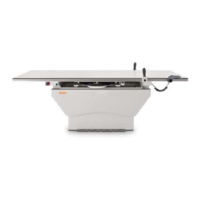Chapter 3 Theory of Operation
28
Models QT-740 & QT-750 - Service Manual
was triggered by the UP signal produced by A1U2C-10.) The low output
from A1U6A-6 de-energizes UP relay A1K1 through components A1D18,
A1U4B, A1U1A, and A1U4A and INHIBIT relay A1K4 through A1U2A,
A1U4B, and A1U1C. The motor drive circuit is interrupted, thereby stop-
ping tabletop vertical motion.
• Limitation of upward travel for the Scissors Assembly is accomplished by
Up Limit switch S8 and redundant Up Limit switch S9. The switches are
mounted on the table base plate close to the Ball Nut Assemblies, which
interface the Scissors Assembly with the lead screws. When the tabletop
is raised, the lead screws drive the Ball Nut Assemblies toward the Up
Limit Switches. At the point where switches S8 and/or S9 are activated
(contacts open), a high UP LIMIT signal is applied through A1J2-14 to
buffer/level shifter A1U3F. The low output from A1U3F de-energizes UP
relay A1K1 through components A1D11, A1U4B, A1U1A, and A1U4A and
INHIBIT relay A1K4 through A1D11, A1U4B, and A1U1C. The motor drive
circuit is interrupted, thereby stopping tabletop vertical motion.
• A sensor is located on the Drive and Sync belts to detect the presence of
each belt. Normally, Drive Belt Sensor Switch S22 and Sync Belt Sensor
Switch S23 are closed applying a low (ground) through A1J2-19 to tran-
sistor A1Q4. The low signal turns off A1Q4, causing the input at A1U5B-5
to be high. The resulting low output at A1U5B-7 enables the motor drive
circuit for operation as described previously. In the event a belt breaks,
S22 and/or S23 open removing the ground at A1J2-19. Transistor A1Q4
turns on applying a low input to A1U5B-5, which outputs a high signal at
A1U5B-7. The motor drive circuit is interrupted, thereby disabling DC
motor operation.
• An temperature monitoring sensor mounted on the DC Motor monitors its
temperature. If the temperature exceeds 70°C, the switch opens and
disables the DC Motor operation in the same manner as the drive belt
sensors, described in the previous paragraph.
Table Down Motion Control
When the DOWN foot pedal is depressed, switch S2 contact is connected to
ground. The ground is applied through 6-Way Table Control Board connector
A1J2-11 as an active low /DN signal, which is input to NOR gate A1U2D. This
produces a high output at A1U2D-13, which is inverted low by A1U4D. The out-
put from A1U4D energizes the coil of DOWN relay A1K3 through 150 ms delay cir-
cuit A1U1B, A1C8, A1R16, A1R14, and A1U4C. (Since A1U4D's output is a low-
going signal, A1C8 discharges in approximately 1 millisecond through A1D7 and
A1R14, which immediately energizes A1K3). When A1K3 is energized, the CON-
TROLLER(-) signal from DC Motor Driver Board A2 is connected to the DC motor
(through A1J1-12) as the MOTOR+BRK RES signal. The low-going signal from
A1U4D is also applied to A1D10 and A1R22 to discharge A1C9 to a voltage level
that will cause the output of A1U1C to go low in approximately 150 milliseconds.
This energizes A1K4, which removes the connection from A1J1-1 and A1J1-9,
thus allowing the DC motor to rotate. The INHIBIT outputs are applied through

